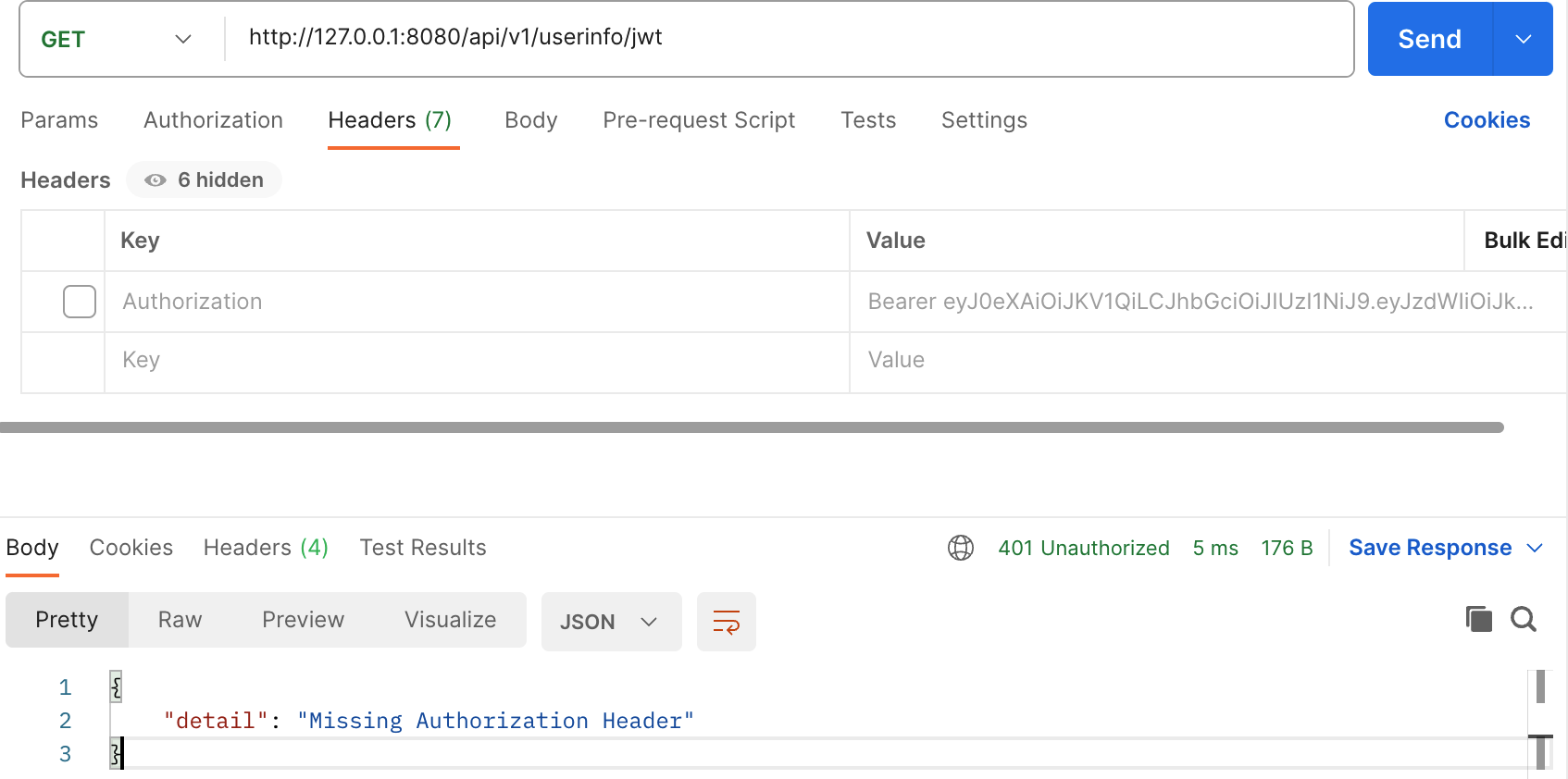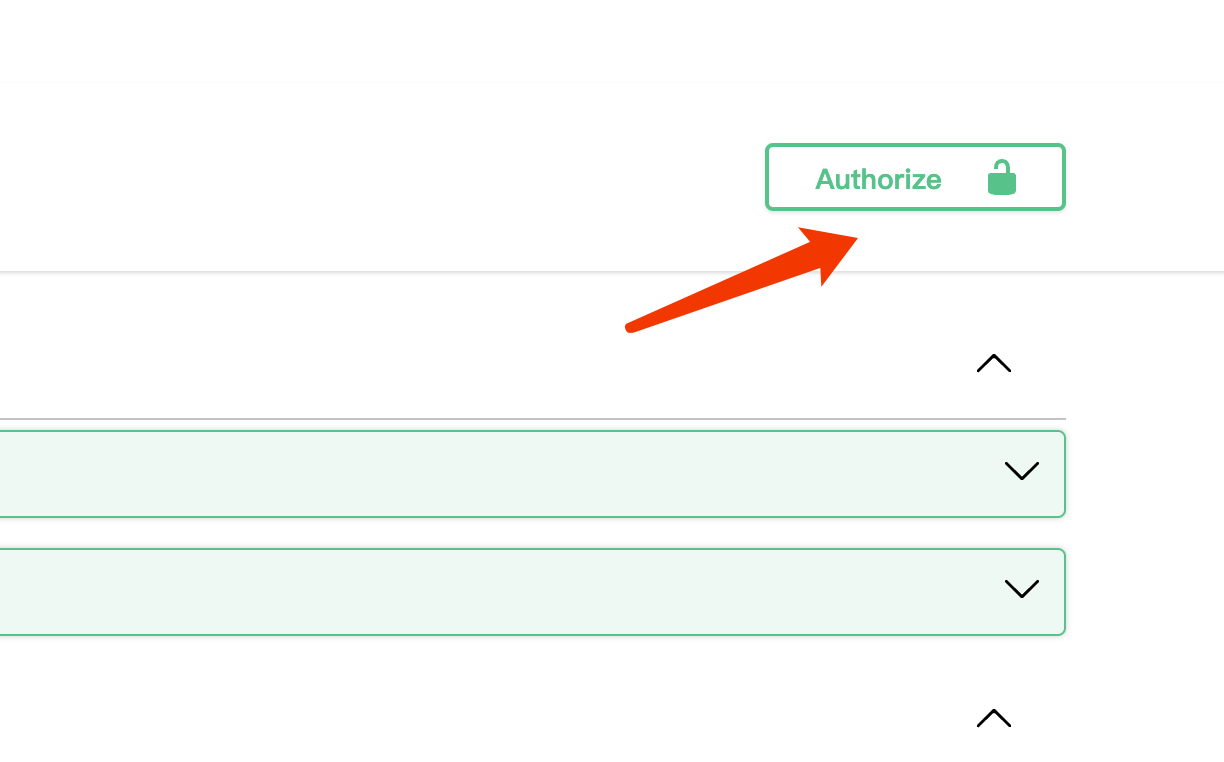fastapi项目 04-JWT-Token
前言
对于 flask ,有 flask-jwt-extended 插件快速实现生成登录token。fastapi-jwt-auth .它的灵感来自于flask-jwt-extended。
官网教程地址https://indominusbyte.github.io/fastapi-jwt-auth/usage/basic/。
1. fastapi-jwt-auth演示
首先需要通过fastapi库生成登录token:pip install fastapi-jwt-auth。打开上面这个库的官方文档,我们将官方给的例子,拷贝下来。
from fastapi import FastAPI, HTTPException, Depends, Request
from fastapi.responses import JSONResponse
from fastapi_jwt_auth import AuthJWT
from fastapi_jwt_auth.exceptions import AuthJWTException
from pydantic import BaseModel
import uvicorn
app = FastAPI()
class User(BaseModel):
username: str
password: str
# in production you can use Settings management
# from pydantic to get secret key from .env
class Settings(BaseModel):
authjwt_secret_key: str = "secret"
# callback to get your configuration
@AuthJWT.load_config
def get_config():
return Settings()
# exception handler for authjwt
# in production, you can tweak performance using orjson response
@app.exception_handler(AuthJWTException)
def authjwt_exception_handler(request: Request, exc: AuthJWTException):
return JSONResponse(
status_code=exc.status_code,
content={"detail": exc.message}
)
# provide a method to create access tokens. The create_access_token()
# function is used to actually generate the token to use authorization
# later in endpoint protected
@app.post('/login')
def login(user: User, Authorize: AuthJWT = Depends()):
if user.username != "test" or user.password != "test":
raise HTTPException(status_code=401, detail="Bad username or password")
# subject identifier for who this token is for example id or username from database
access_token = Authorize.create_access_token(subject=user.username)
return {"access_token": access_token}
# protect endpoint with function jwt_required(), which requires
# a valid access token in the request headers to access.
@app.get('/user')
def user(Authorize: AuthJWT = Depends()):
Authorize.jwt_required()
current_user = Authorize.get_jwt_subject()
return {"user": current_user}
if __name__ == '__main__':
uvicorn.run(app='basic:app', host='0.0.0.0', port=8081)
# 这是官方文档给出的test示例,作为参考。
$ curl http://localhost:8000/user
{"detail":"Missing Authorization Header"}
$ curl -H "Content-Type: application/json" -X POST \
-d '{"username":"test","password":"test"}' http://localhost:8000/login
{"access_token":"eyJ0eXAiOiJKV1QiLCJhbGciOiJIUzI1NiJ9.eyJzdWIiOiJ0ZXN0IiwiaWF0IjoxNjAzNjkyMjYxLCJuYmYiOjE2MDM2OTIyNjEsImp0aSI6IjZiMjZkZTkwLThhMDYtNDEzMy04MzZiLWI5ODJkZmI3ZjNmZSIsImV4cCI6MTYwMzY5MzE2MSwidHlwZSI6ImFjY2VzcyIsImZyZXNoIjpmYWxzZX0.ro5JMHEVuGOq2YsENkZigSpqMf5cmmgPP8odZfxrzJA"}
$ export TOKEN=eyJ0eXAiOiJKV1QiLCJhbGciOiJIUzI1NiJ9.eyJzdWIiOiJ0ZXN0IiwiaWF0IjoxNjAzNjkyMjYxLCJuYmYiOjE2MDM2OTIyNjEsImp0aSI6IjZiMjZkZTkwLThhMDYtNDEzMy04MzZiLWI5ODJkZmI3ZjNmZSIsImV4cCI6MTYwMzY5MzE2MSwidHlwZSI6ImFjY2VzcyIsImZyZXNoIjpmYWxzZX0.ro5JMHEVuGOq2YsENkZigSpqMf5cmmgPP8odZfxrzJA
$ curl -H "Authorization: Bearer $TOKEN" http://localhost:8000/user
{"user":"test"}
我们重新运行它的例子,看看是否如其所说。


2. 生成登录token
根据官方文档所给的示例,我们在工厂函数中增加获取JWT配置以及校验。
# apps/__init__.py
def create_app():
"""工厂函数"""
app = FastAPI()
@AuthJWT.load_config
def get_config():
return Settings()
# exception handler for authjwt
# in production, you can tweak performance using orjson response
@app.exception_handler(AuthJWTException)
def authjwt_exception_handler(request: Request, exc: AuthJWTException):
return JSONResponse(
status_code=exc.status_code,
content={"detail": exc.message}
)
# 注册view路由
app.include_router(view_jwt.router, prefix="/api/v1", tags=["登录token"])
增加view_jwt函数。
from fastapi import APIRouter, Depends, HTTPException
from apps.model.schemas import UserIn
from fastapi_jwt_auth import AuthJWT
router = APIRouter()
@router.post("/login/jwt")
async def login_jwt_token(user: UserIn, Authorize: AuthJWT = Depends()):
if user.username != "test":
raise HTTPException(status_code=401, detail="Bad username or password")
# subject identifier for who this token is for example id or username from database
access_token = Authorize.create_access_token(subject=user.username)
return {
"code": "0000",
"message": "Login Successful",
"body": {"access_token": access_token}
}
运行启动,并且测试。


3. 数据库校验
创建完登录的token后,我们需要连接数据库,来校验我们登录的账号和密码是否正确。
# 创建数据库密码校验crud
# apps/model/crud.py
from apps.model.models import User
from fastapi import HTTPException
from sqlalchemy.orm import Session
def check_user_password(db: Session, user):
db_user = db.query(User).filter_by(username=user.username).first()
return db_user.verify_password(user.password)
# 优化登录接口,连接数据库进行校验密码是否正确
from apps.model import crud
from sqlalchemy.orm import Session
from apps.dependency import get_db
@router.post("/login/jwt")
async def login_jwt_token(user: UserIn, db: Session = Depends(get_db), Authorize: AuthJWT = Depends()):
# 1. 先校验用户名是否存在
if not crud.is_user_exist(db, user):
raise HTTPException(status_code=404, detail="用户名或者密码错误")
if not crud.check_user_password(db, user):
raise HTTPException(status_code=404, detail="用户名或者密码错误")
# 2.生成token
access_token = Authorize.create_access_token(subject=user.username)
return {
"code": "0000",
"message": "Login Successful",
"body": {"access_token": access_token}
}
通过postman进行验证接口是否校验数据库密码成功。



4. 后面接口传token
登录完后,需要操作其他的接口,一般都是需要带上登录接口返回的token的,并且一般都是以:Authorization:Bearer access_token的形式传入到请求头部的。只需要下一个接口中增加Authorize.jwt_required(),即可实现。
@router.get("/userinfo/jwt")
async def get_user_info(Authorize: AuthJWT = Depends()):
Authorize.jwt_required() # 该接口请求,需要传token header
# 该token的用户
current_user = Authorize.get_jwt_subject()
return {"current_user": current_user}

我们增加token后,postman查看返回是否正确。

4.1 额外增加接口返回的数据
获取用户信息接口,一般都需要从数据库中,返回用户的全部信息,所以需要额外通过获取数据库中用户的信息,再将其返回。
# 修改crud.py文件,修改如下,返回用户的数据信息
def is_user_exist(db: Session, user):
q_user = db.query(User).filter_by(username=user.username)
if q_user.count() > 0:
return q_user.first()
else:
return False
# 修改登录接口,并添加user_claims参数即可
@router.post("/login/jwt")
async def login_jwt_token(user: UserIn, db: Session = Depends(get_db), Authorize: AuthJWT = Depends()):
# 1. 先校验用户名是否存在
get_user_info = crud.is_user_exist(db, user)
if not get_user_info:
raise HTTPException(status_code=404, detail="用户名或者密码错误")
if not crud.check_user_password(db, user):
raise HTTPException(status_code=404, detail="用户名或者密码错误")
# 2.生成token
# access_token = Authorize.create_access_token(subject=user.username)
# 获取其他额外的内容
# 2.1 获取登录用户的id
user_id = get_user_info.id
username = get_user_info.username
is_active = get_user_info.is_active
another_claims = {"id": user_id, "username": username, "is_active": is_active}
access_token = Authorize.create_access_token(subject=get_user_info.username, user_claims=another_claims)
@router.get("/userinfo/jwt")
async def get_user_info(Authorize: AuthJWT = Depends()):
Authorize.jwt_required() # 该接口请求,需要传token header
# 该token的用户
# current_user = Authorize.get_jwt_subject()
another_claims = Authorize.get_raw_jwt() # 通过Authorize.get_raw_jwt()获取到用户的数据库信息
return {"body": another_claims}

4.2 添加cookies
如果访问的客户端是浏览器,则还需要添加cookies。只需要在登录的时候,添加cookies就行,另外还需要添加cookies的配置。
access_token = Authorize.create_access_token(subject=get_user_info.username, user_claims=another_claims)
# 若是浏览器访问则需要添加cookies
Authorize.set_access_cookies(access_token)
# apps/__init__.py
class Settings(BaseModel):
authjwt_secret_key: str = "secret"
# Configure application to store and get JWT from cookies
authjwt_token_location: set = {"cookies"}
# 设置cookie有效期30天,如果不设置默认关闭浏览器cookie失效
authjwt_cookie_max_age: int = 60 * 60 * 24 * 30
# 使用Cookie时启用 / 禁用CSRF保护。默认为True
authjwt_cookie_csrf_protect = False
5. swagger 生成Authorize按钮
将下面的代码复制到,工厂函数中即可。
import re
import inspect
from fastapi.routing import APIRoute
from fastapi.openapi.utils import get_openapi
def custom_openapi():
if app.openapi_schema:
return app.openapi_schema
openapi_schema = get_openapi(
title="My Auth API",
version="1.0",
description="An API with an Authorize Button",
routes=app.routes,
)
openapi_schema["components"]["securitySchemes"] = {
"Bearer Auth": {
"type": "apiKey",
"in": "header",
"name": "Authorization",
"description": "Enter: **'Bearer <JWT>'**, where JWT is the access token"
}
}
# Get all routes where jwt_optional() or jwt_required
api_router = [route for route in app.routes if isinstance(route, APIRoute)]
for route in api_router:
path = getattr(route, "path")
endpoint = getattr(route, "endpoint")
methods = [method.lower() for method in getattr(route, "methods")]
for method in methods:
# access_token
if (
re.search("jwt_required", inspect.getsource(endpoint)) or
re.search("fresh_jwt_required", inspect.getsource(endpoint)) or
re.search("jwt_optional", inspect.getsource(endpoint))
):
openapi_schema["paths"][path][method]["security"] = [
{
"Bearer Auth": []
}
]
app.openapi_schema = openapi_schema
return app.openapi_schema
app.openapi = custom_openapi


6 退出登录
退出登录接口,先校验用户是否登录Authorize.jwt_required() ,再删除cookies Authorize.unset_jwt_cookies()。
@router.delete('/logout')
async def logout(Authorize: AuthJWT = Depends()):
"""
因为JWT现在存储在httponly cookie中,
我们不能通过简单地删除前端的cookie来注销用户。
我们需要后台向我们发送删除cookie的响应。
"""
Authorize.jwt_required()
# 删除cookies
Authorize.unset_jwt_cookies()
return {"msg": "Successfully logout"}






【推荐】国内首个AI IDE,深度理解中文开发场景,立即下载体验Trae
【推荐】编程新体验,更懂你的AI,立即体验豆包MarsCode编程助手
【推荐】抖音旗下AI助手豆包,你的智能百科全书,全免费不限次数
【推荐】轻量又高性能的 SSH 工具 IShell:AI 加持,快人一步
· 分享一个免费、快速、无限量使用的满血 DeepSeek R1 模型,支持深度思考和联网搜索!
· 基于 Docker 搭建 FRP 内网穿透开源项目(很简单哒)
· ollama系列01:轻松3步本地部署deepseek,普通电脑可用
· 25岁的心里话
· 按钮权限的设计及实现